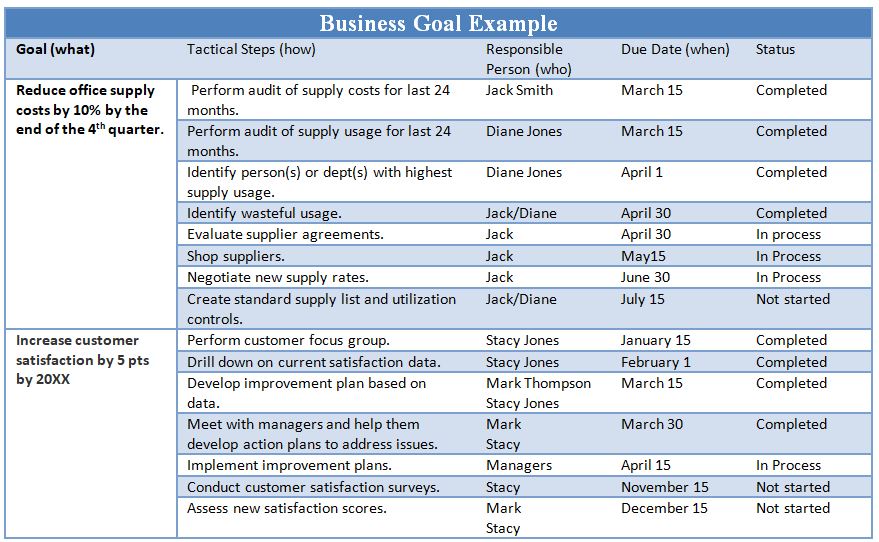Do You Know How To Write Business Goals?
Estimated reading time: 5 minutes
Businesses need to plan to be successful. An important part of the business planning process is determining business objectives that are translated into actionable business goals.
Goals should support the strategic plan – a written document that articulates an organization’s strategy for achieving its mission and vision.
The goal development process looks at this strategy and determines the necessary steps to get there.
You can determine the steps by asking who, what, when, and how.
For instance, let’s say your flower business has a goal of expanding its products by adding memorial gifts for loved ones. This goal would require a plan that determines, what needs to be done, steps (how) to get it done, who will do it, and when it should be completed.
Goal writing does not have to be overly complicated.
But, it does require commitment and the discipline to follow through and complete the required action steps.
Spend time to think through your goals so that you can have enough detail to achieve your desired results.
To do this, many organizations use the SMART goal model to articulate their goals.
Mục Lục
SMART Goals are:
Specific – Is the goal specific enough for clarity?
Measurable – Is there a way to measure the goal? In other words, how do you know you achieved the goal?
Attainable – Is the goal truly attainable? Or is it such an outlandish goal that it looks good on paper but is nearly impossible to complete.
Realistic – Did you write the goal realistically? For example, did you address all the challenges of completing the goal and provide the necessary resources?
Timely – Is there a timeline associated with the goal to ensure a completion date?
“If you can’t measure and monitor your goals, chances are that your employees will never achieve them and you won’t know the difference…” Managing for Dummies

A company’s goals should be written to support activities that contribute to the organization’s ability to move forward – increasing revenues, decreasing costs, and improving the customer experience.
Examples of SMART Business Goals
1. Reduce overall budget costs by 10% by 20xx
2. Increase market share by 5% by 20xx
3. Increase revenues by 20% by 20xx
4. Increase customer satisfaction by 5 pts by 20xx
Let’s look at the goal of reducing overall budget costs by 10% by 20xx flush out the detail of that goal.
If you take one aspect of budget costs, which could be supply costs, you can write SMART goals to reduce them.
How Do I Write A Business Goal?
The goal development process includes a discussion with the appropriate people (those closest to the process) and should answer the questions: who, what, when, and how.
These four questions help to facilitate a discussion and thought process that flushes out the details needed for writing effective goals.
Ok, now let’s brainstorm steps to reduce the office supply budget (what) and this is what we might find:
- Audit supply costs for the last 24 months – How
Who – Jack
When – March 15
- Audit supply usage for the last 24 months – How
Who – Diane
When – March 15
- Identify the person(s) or departments with the highest supply usage – How
Who – Diane
When – April 1
- Identify potential wasteful usage – How
Who – Jack/Diane
When – April 30
- Evaluate supplier agreements – How
Who – Jack
When – April 30
- Shop suppliers – How
Who – Jack
When – May 15
- Negotiate new supply rates – How
Who – Jack
When – June 30
- Create a standard of supply list and utilization control – How
Who – Jack/Diane
When – July 15
Once the questions are answered a goal setting worksheet can be created as an easy visual of the goal plan.
Now let’s look at a couple of these goals and put them in a goal document.

Follow Through Is The Most Important Step
One of the most important things when writing goals is the follow-up and completion of goals.
A goal document is no more than a piece of paper if there is not a person held accountable for achieving those goals. Assign responsible people to each task and hold them accountable.
One tip I have is to ask the person when a reasonable time would be to get the task done and hold them to it.
When an employee determines their own deadlines, they will be less likely to claim unrealistic expectations.
Use the document as a tool to help manage the performance of the employees assigned to complete the action steps and also include these goals in the annual performance appraisal process.
Managers should use this goal sheet as a guide throughout the year and reinforce the deadlines outlined in the document.
Why Is it Important To Manage Employee Performance?
Employees go to work with the intention of doing a good job. It is the manager’s responsibility to set expectations for performance, provide the resources to do their job, and then hold them accountable for those expectations.
A structured performance management process is critical to ensuring goal completion. The process should also include rewards and recognition for employees.
Use incentives to engage employees and reward them for their labor.
An organizations’ ability to write and accomplish annual goals is critical to achieving corporate objectives.
Take the time to think about what needs to be done and create a document that assigns responsibility. You will find that achieving your objectives are more realistic than you might think!
If you would like an editable copy of this example of business goal document – click here.
Does your organization write annual goals?















![Toni Kroos là ai? [ sự thật về tiểu sử đầy đủ Toni Kroos ]](https://evbn.org/wp-content/uploads/New-Project-6635-1671934592.jpg)


